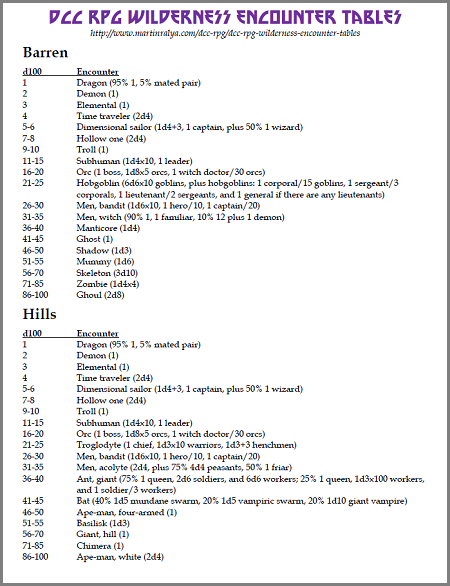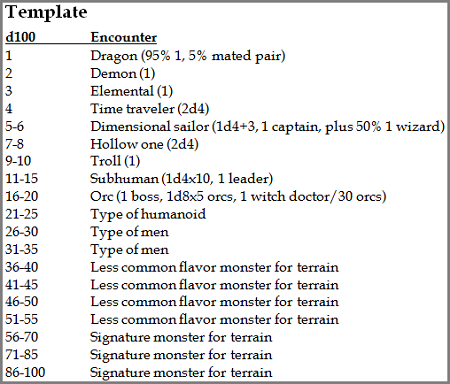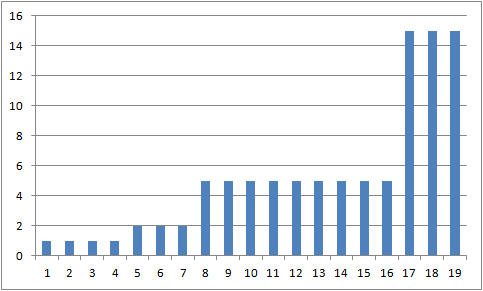I needed wilderness encounter tables for the DCC RPG (paid link) hexcrawl I’m running, but there aren’t any in the book. Jeff Rients created some excellent tables for wandering monsters by dungeon level (which also appear in Crawl! #5), but after searching high and low I couldn’t find any wilderness encounter tables online. So I created some.
They’re broken down by terrain type (for “fantasy western Europe”) and include number appearing for each monster. You can download them as a free PDF: DCC RPG Wilderness Encounter Tables. They’re also available as a plain text file so that you can fiddle with them to your heart’s content.
(2018 update: My tables, along with a shortened version of the design notes, appear in The Gongfarmer’s Almanac – Volume 3, 2018 (paid link), with excellent editing by Rob Brennan.)

There’s no scaling by PC level or party size in these tables, and they’re not “balanced” in any way. The world is the world, and what’s out there is what’s out there.
To use them, you’ll need a way of figuring out whether or not a random encounter takes place (I use the system from the B/X Expert Set [paid link]). That’s all!
I love design notes in gaming books, and a surprising amount of design goes into making wandering monster tables (these took me about 12 hours to make!), so the rest of this post is about my goals, process, assumptions, and the theory behind my tables.
Design goals
I went in with a few goals in mind:
- Quick and dirty — when in doubt, make the choice that sounds the most fun, and do a lot with one roll
- Showcase the flavor of DCC
- Give each terrain type its own feel, which should be discernible to players after just a few encounters
- Use only the monsters in the DCC core book, and use whatever they say (including rarity)
- Don’t have too few monsters, because lack of variety is dull
- But don’t have too many, either, because that dilutes each terrain type
- Reflect “fantasy western Europe,” and a borderlands/wilderlands kind of region
- Match the terrain types I used in Hexmancer, my system for procedurally generating hexcrawl terrain and features
- Play nice with B/X D&D’s encounter chances by terrain type, since that’s what I use
The overuse of “men” in the monster names, while matching the feel of Appendix N, bugs me, but I figured changing it would make these tables less useful to others, so I left all of the monster names as-is.
Baseline
My baseline was always “What does the DCC rulebook say?”
If a monster entry listed terrain types, number appearing, relative rarity, or other details, I used those. If it didn’t, I looked at B/X and/or Jeff’s wandering monster list, and then came up with something that felt right to me.
I excluded monsters that are listed as underground-only, as well as the weird ones that seem like they’d work best as placed encounters, not random ones (extradimensional analogues, for example). I also left out things that only live in hot places or jungles (which aren’t in fantasy western Europe, or in Hexmancer).
Massage, dismantle, repeat
My first step was to list every DCC monster under all of the terrain types where it could appear. That gave me a picture of what a world created with this monster manual might look like, as well as some unique monster for specific terrain types and a host of critters that appear only in a couple places — both great starting points for flavor.
It’s not a short list, but it is short on specific things — normal animals, for example. And it’s a quirky list, which I like! Sure, the world likely does have animals in it the PCs could meet . . . but I didn’t worry about that.
I started out with d8+d10 tables, because that roll produces one of my favorite distributions for encounter tables. But I quickly found that I wanted more granularity, which led me to percentile tables. Those also have the added advantage of making the odds immediately discernible, which I like.
A few hours in, I hit on the idea of creating a template table based on the concept of using “brackets” of monsters to convey things about the world.

Broken out, those brackets look like this (in the order they occur on the table):
- 10% (1-10) say a lot about the world (and the style of game I like to run), while being quite rare. Results 1-10 are on every table except Water, a big-picture statement about what kind of world feels like DCC to me.
- 25% (11-35) emphasize the importance of humans and humanoids. Humans, humanoids, and subhumans (which are kind of like a mix of both), are on every table.[1] Humans are big in sword and sorcery fiction, and humanoids are big in D&D.
- Taken in aggregate, the first 35% (1-35) also serve another purpose: Most of them are things that won’t always just try to eat you. Intelligent monsters, and encounters that aren’t always fights, are both good things in my book.
- 20% (36-55) round out the flavor of the terrain type. These are often unique to the terrain type, but not always, and they’re indicative of what kind of place it is.
- 45% (56-100) define the terrain type. You have a 45% chance of meeting each terrain type’s signature monsters. More than anything else on the table, these convey what that terrain is all about.
Seeing those odds in graph form also helped me decide that this was a fun distribution model (column height equals percentage chance of that encounter):

Having a template really sped up the process, too, because it made it feel less daunting. Instead of staring at long lists and not being sure quite where to start, I could just look at each terrain type and go, “Okay, which three say ‘forest’ best? Cool, now which four also look like good forest options?”
I ripped apart my draft tables a couple of times, but once I built them using these brackets they stayed pretty stable. My last couple iterations mostly involved comparing the lists, looking for ways to sneak in monsters I regretted not including (so many!), and — most importantly — making sure that the flavor of each terrain type came through clearly.
In B/X, some types of terrain are more dangerous than others by virtue of how likely it is you’ll have an encounter there: 1 in 6 on clear terrain (plains) vs. 3 in 6 in the mountains, for example. The way my lists shook out, some terrain types are also more dangerous because of what’s on them. For example, you’re 40% likely to meet some sort of giant in the mountains, which seems like fun to me.
Surprises and rolling your own
Two things surprised me about this process: how much work it was, and how personal it turned out to be. If two GMs sat down with the DCC book and designed wilderness encounter tables, I guarantee they’d look different — and probably not much like mine!
They’d use different die rolls, different breakdowns of monsters, and different philosophies about what a DCC world looks like. One would follow the B/X model of rolling once for terrain and then again on a sub-table for that terrain; another would compress things into one roll, like I did, but use 2d6 instead of d100. And since they’d both have to choose a subset of the overall monster list, they’d play favorites (just like I did!).
Chances are, if you’ve read this far, you can think of all sorts of things you’d do differently in building a set of DCC RPG wilderness encounter tables. I included my template in the plain text version, in case you like that baseline.
If you make your own tables, I’d love to see them. Post them somewhere and share them with the DCC community — the more the merrier!
[1] Except Water. Just add “except Water” to pretty much everything. Water is weird because there just aren’t that many water monsters in the DCC core book.

Pingback: Daily Snapshot – March 16, 2016 – OSR Today
This is great work, and your thoughts on DCC are inspiring. Thanks for sharing these tables — I don’t doubt they’ll find a home at my own!
I am gonna have to tinker, though — I have grand aspirations beyond (“mere”) fantasy western Europe!
Thanks again.
You’re most welcome! I’d love to see the non-WE tables you come up with.